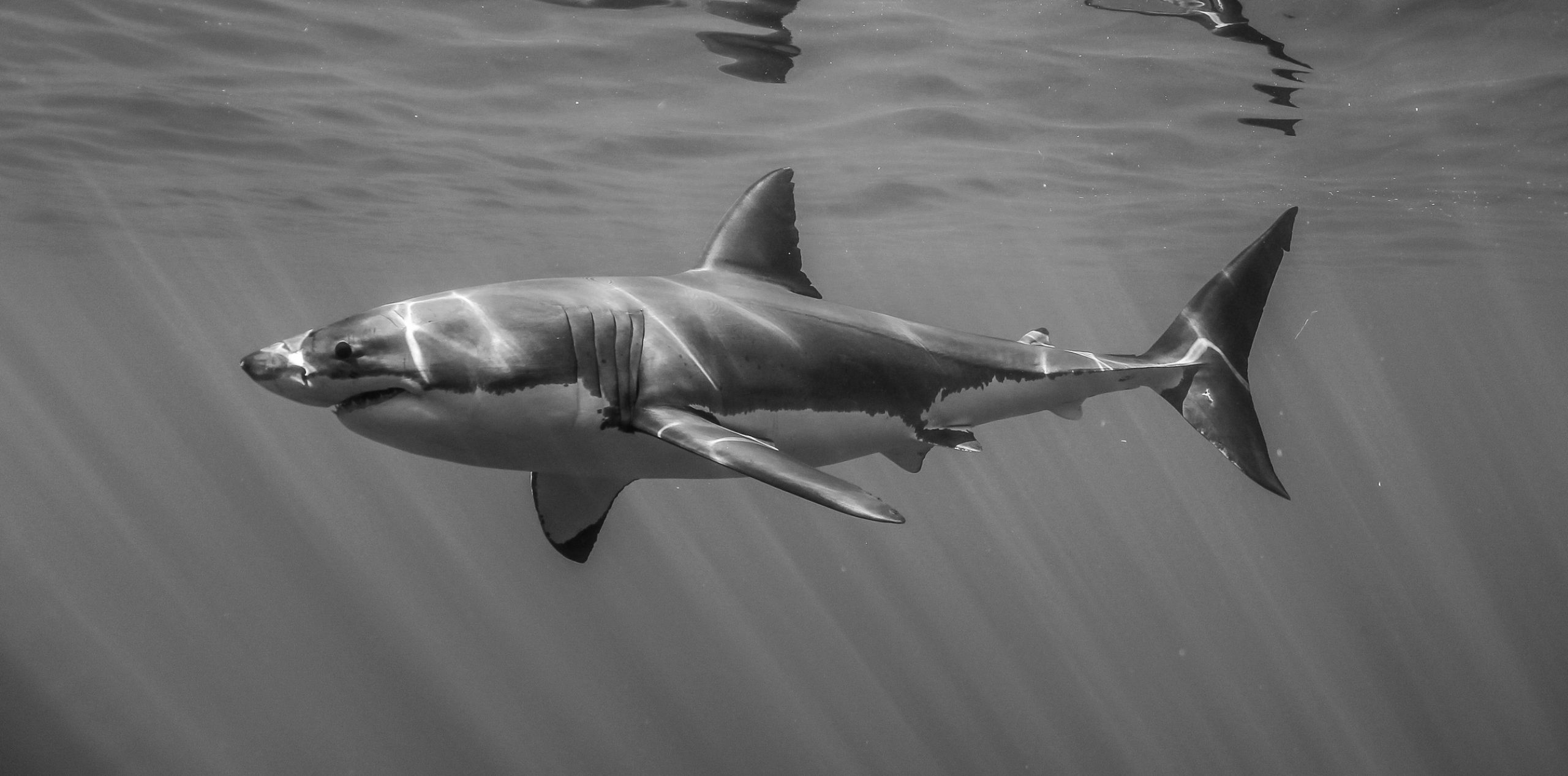In Search of a Plankton Feeder
The Basking Shark (Cetorhinus maximus) can reach lengths of up to 12m and is the largest shark in British waters and the second largest in the world after the Whale Shark. Both are plankton feeders, and it is the plankton rich water (primarily along the West Coast) during the spring and summer months which results in these giants visiting our shores.
Despite the basking shark belonging to the same family, as the great white shark (Lamniformes) it is in a genus of its own: Cetorhinidae. Of course being a plankton eater can make it rather more elusive than a great white and baiting it in is out of the question! However understanding more about how basking sharks feed and their prey certainly helps when trying to locate them in the Ocean. Dr Dave Sims and his team at the Plymouth Marine Laboratory have undertaken a substantial amount of work in this area;
Originally it was thought that basking sharks were indiscriminate filter feeders, engulfing whatever was suspended in front of them. However, Sims et al have shown that sharks elect to feed in waters which contain higher concentrations of their preferred prey species which happen to be planktonic shrimp. It is not known for certain how sharks actually locate high concentrations of these shrimp but there are currently a couple of theories. One theory is that sharks are capable of detecting the odour of dimethyl sulphide (DMS) emitted by phytoplankton when it is being grazed on by zooplankton. The second theory is that the sharks can detect activity of their prey using their electroreceptors known as Ampullae of Lorenzini.
Basking sharks feed at varying depths in the water column exploiting optimal food sources (deep sea shrimp have been found in their stomach contents). Sims et al reported that sharks do not feed when the plankton concentration is less than 1 gram of plankton per cubic meter of water, presumably because it is energetically not worthwhile. The higher the plankton concentration, the longer the sharks feed. When the plankton reach concentrations of 3 grams of per cubic meter of water the sharks will feed for up to two and a half times longer than when it’s at 1 gram. When they find a good place to feed they adopt a zigzag swimming pattern, this behaviour is termed “area restricted searching” or ARS. A preference for feeding occurs at current fronts where two water masses of different temperature meet. When the sea is calm less mixing occurs and the water stratifies into different layers, typically warmer on top, cooler below. This may result in the plankton experiencing low nutrient levels. Therefore plankton levels are higher where waters of different temperatures mix, such as at a thermal front. These fronts can be seen as almost slick lengths of still water and can be very useful for spotting sharks near the surface, these fronts can also collect quantities of debris such as jellyfish and seaweed which can make their identification even more obvious.
Basking sharks feed by a method known as obligate ram filter-feeding (Whale Sharks feed by a different technique known as suction feeding). They cruise along when feeding (typically around 1.9 miles per hour), with their mouth wide open, allowing the plankton rich water to pass through the gill slits where it is filtered out by gill rakers, near the rakers are cells which secrete large quantities of mucous when the shark closes its mouth (usually after 30-60 seconds), the rakers collapse squeezing the plankton mucous mixture into the mouth so it can be swallowed.
Many thanks to Richard Aspinall for the use of his images in this post.
References and Further Reading
Sims D.W. (1999) Threshold foraging behaviour of basking sharks on zooplankton: life on an energetic knife-edge? Proc. R.Soc.Lond. B.266:1437-1443.
Sims D.W.(2000) Filter-feeding and cruising speeds of basking sharks compared to optimal models: they filter-feed slower than predicted for their size. Jour. Exp. Mar. Biol. Ecol. 249: 65-76.
Sims D.W., Fox A.M. and Merret D.A. (1997) Basking shark occurrence off south-west England in relation to zooplankton abundance. J.Fish.Biol 51: 436-440.
Sims D.W. and Merret D.A. (1997) Determination of zooplankton characteristics in the presence of surface feeding basking sharks Cetorhinus maximus. Mar. Ecol. Prog. Ser. 158: 297-302.
Sims D.W. and Reid P.C. (2002) Congruent trends in long-term zooplankton decline in the north-east Atlantic and basking shark (Cetorhinus maximus) fishery catches off west Ireland. Fish. Oceanogr. 11:1: 59-63.
Sims D.W., Southall E.J., Richardson A.J., Reid P.C. and Metcalf J.D. (2003) Seasonal movements and behaviour of basking sharks from archival tagging: no evidence of winter hibernation. Mar.Ecol.Prog.Ser 248: 187-196.
Sims D.W., Southall E.J., Quayle V.A. and Fox A.M. (2000) Annual social behaviour of basking sharks associated with coastal front areas. Proc.R. Soc. Lond B. 267: 1897-1904.
Sims D.W and Quayle V.A. (1998) Selective foraging behaviour of basking sharks on zooplankton on a small scale front. Nature: 393: 460-464.



















 Pygmy Devil ray in full flight over reef
Pygmy Devil ray in full flight over reef